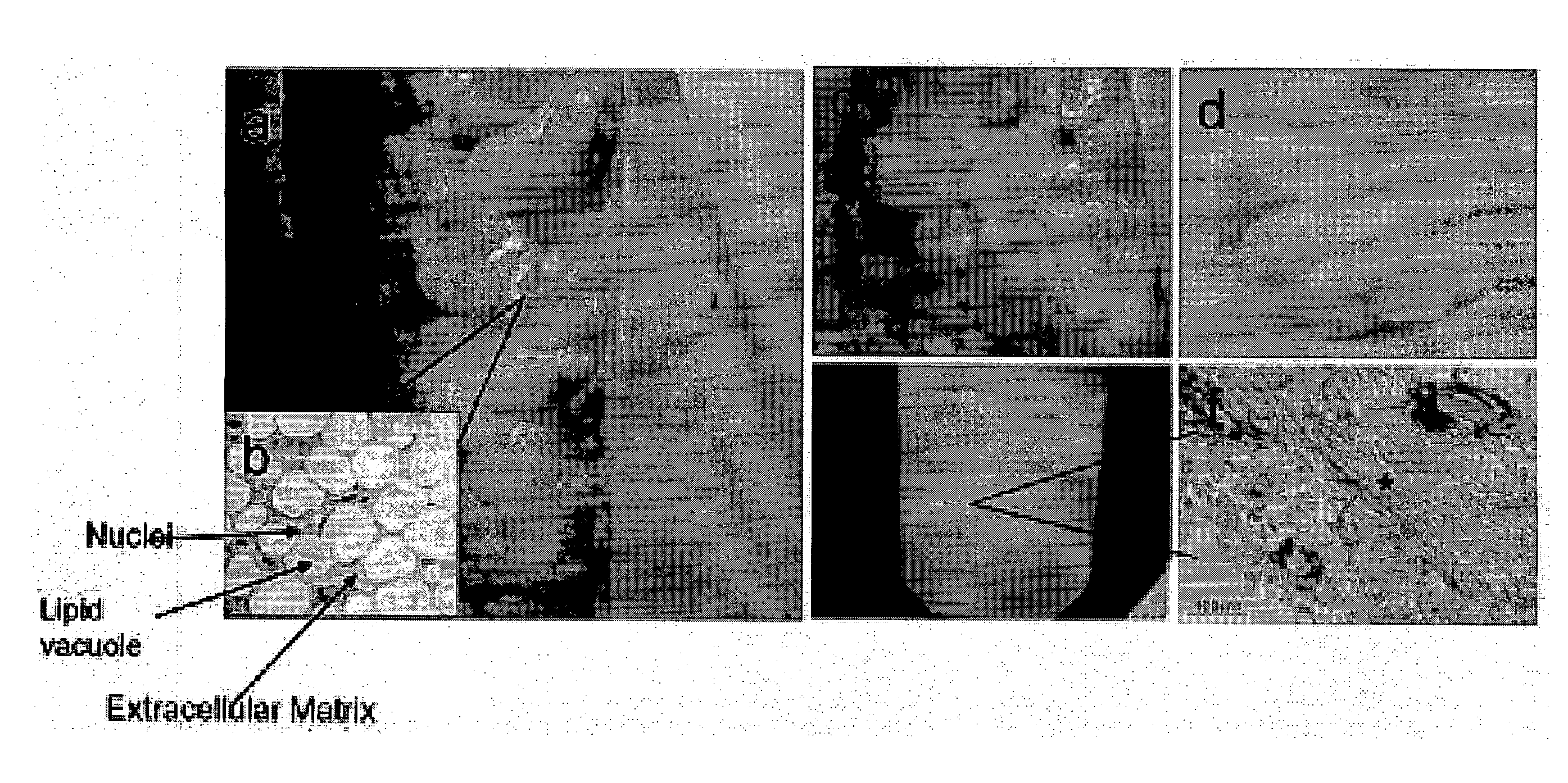Compositions and methods for implantation of adipose tissue and adipose tissue products
a technology of adipose tissue and products, applied in the field of regenerative medicine, can solve the problems of high cost of methods, significant time-consuming and laborious, and procedures also have limitations
- Summary
- Abstract
- Description
- Claims
- Application Information
AI Technical Summary
Benefits of technology
Problems solved by technology
Method used
Image
Examples
example 1
Preparation of a Cellular Biocompatible Biomaterial
[0106]A lipoaspirate was obtained using standard minimally invasive surgical techniques. Tumescent fluid was removed and the lipoaspirate was placed on ice until next step. The lipoaspirate was combined with various surfactants and scaffolds for the preparation of the biocompatible biomaterial.
[0107]1. Hyaluronic acid was emulsified with lipoaspirate in a 1:1 ratio with the addition of 5% Pluronic surfactant.
[0108]2. A 10% weight per volume PEG-DA was dissolved in a 50:50 ratio of PBS:Lipoaspirate.
[0109]The HA used was a commercially available crosslinked HA which requires no cross-linker and can be molded by hand.
[0110]A photoinitiator was prepared and added for the polymerization of the PEG-DA mixture. Initiator solution was prepared by dissolving eosin Y disodium salt (Sigma-Aldrich CAT# 45235, which absorbs most strongly in the 450-550 nm wavelength range) in PBS (GIBCO CAT# 14190342) (1.375 mg / ml Eosin Y). 100 mg (10% w / v) PEOD...
example 2
Preparation of Acellular Biomaterial / Processed Adipose Tissue (PAT)
[0114]Tissue acquisition and processing. Tissue was acquired from fresh surgical and cadaveric sources with appropriate consent of the donors. A representative sample of subcutaneous fat is shown in FIG. 4A. A representative histological section showing nuclei, lipid vacuoles, and extracellular matrix is provided in FIG. 4B. Subcutaneous fat was isolated from the sample by scraping and transferred to a tube for solubilization using peracetic acid (PAA) or deoxycholic acid to promote chemical decellularization. As adipocytes die, oil is released from the cells, and the material is washed with phosphate buffered saline (PBS) to remove debris and bring the pH back to physiological pH. To fully infiltrate the adipose tissue and remove the oil, the material is manually manipulated with a mortar and pestle, or homogenized in a blender or with a press between washes with PBS. As the lipid is removed, the processed adipose m...
example 3
Analysis of Acellular Biocompatible Biomaterial
[0115]The acellular biocompatible biomaterial has been tested using a number of assays to demonstrate that the material is acellular, lipid-free, includes intact extracellular matrix (ECM), and the appropriate dynamic stiffness. Exemplary assays used are provided. Other methods to determine if the material has the desired characteristics are known in the art.
[0116]Cell Free. Hematoxylin and eosin (H&E) staining was performed on paraffin-embedded sections of PAT prepared by at least one of the methods of the previous example to determine the presence of nuclei (cells) (FIG. 4F). No cellular material or nuclei were observed.
[0117]In addition, MHC class I immunostaining is performed to evaluate the presence of antigens. DNA assay has been used to quantify nuclear contents in the tissue. Briefly, for fluorometric DNA assays, calf thymus DNA standards were prepared 0-100 μg / ml DNA. Samples (30 μl of digested tissue) or standards were mixed w...
PUM
| Property | Measurement | Unit |
|---|---|---|
| molecular weights | aaaaa | aaaaa |
| molecular weights | aaaaa | aaaaa |
| molecular weights | aaaaa | aaaaa |
Abstract
Description
Claims
Application Information
 Login to View More
Login to View More - R&D
- Intellectual Property
- Life Sciences
- Materials
- Tech Scout
- Unparalleled Data Quality
- Higher Quality Content
- 60% Fewer Hallucinations
Browse by: Latest US Patents, China's latest patents, Technical Efficacy Thesaurus, Application Domain, Technology Topic, Popular Technical Reports.
© 2025 PatSnap. All rights reserved.Legal|Privacy policy|Modern Slavery Act Transparency Statement|Sitemap|About US| Contact US: help@patsnap.com



